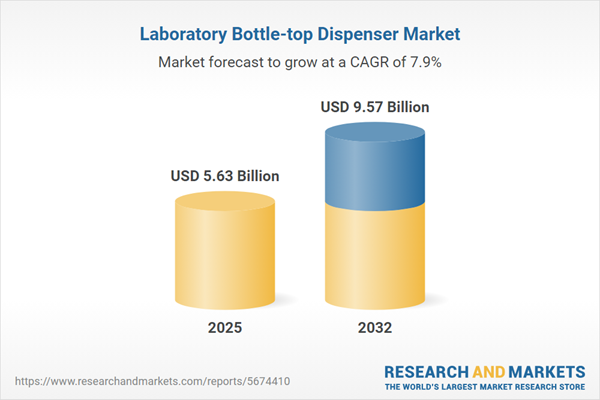Speak directly to the analyst to clarify any post sales queries you may have.
The laboratory bottle-top dispenser market is experiencing substantial momentum as advanced liquid handling solutions become increasingly integral to research, clinical, and industrial laboratories worldwide. Senior decision-makers are focusing on innovations that drive accuracy, sustainable operations, and compliance, resulting in dynamic shifts in procurement, supply chain, and product development strategies.
Market Snapshot: Robust Expansion in Laboratory Bottle-top Dispenser Market
The laboratory bottle-top dispenser market grew from USD 5.21 billion in 2024 to USD 5.63 billion in 2025. It is expected to continue growing at a CAGR of 7.87%, reaching USD 9.57 billion by 2032. This upward trend reflects rising demand for precision, efficiency, and safety across modern laboratories. Shifts in research methodologies, emphasis on compliance, and advancements in digital connectivity are shaping this growth trajectory as laboratories seek reliable sample and reagent management.
Scope & Segmentation: Comprehensive Coverage Across Markets and Technologies
This report offers actionable intelligence on the laboratory bottle-top dispenser landscape. Coverage spans all critical industry segments and geographies, reflecting the diversity of user needs and product solutions shaping the sector. The study highlights:
- End Users: Academic and research institutions, biotech companies, food and beverage companies, healthcare providers (diagnostic laboratories and hospital laboratories), and pharmaceutical companies.
- Applications: PCR setup, reagent dispensing, sample aliquoting, solution preparation, titration.
- Product Types: Electronic (multi-channel and single-channel), manual (peristaltic and piston-driven).
- Volume Ranges: 0.1 to 1 milliliter, 1 to 5 milliliters, 5 to 10 milliliters, 10 to 25 milliliters.
- Distribution Channels: Direct sales, laboratory equipment distributors, scientific product suppliers, company websites, e-commerce platforms.
- Regions: Americas (North and Latin America), Europe, Middle East, Africa, Asia-Pacific.
- Key Companies: Thermo Fisher Scientific Inc., Sartorius AG, Eppendorf AG, BrandTech Scientific, Inc., Gilson, Inc., Cole-Parmer Instrument Company LLC, Hamilton Company, Socorex Isba S.A., IKA-Werke GmbH & Co. KG, DWK Life Sciences GmbH.
Key Takeaways for Decision-Makers
- Adoption of automation and digital integration is accelerating as laboratories prioritize traceability and operational efficiency.
- Sustainable materials and eco-conscious manufacturing are influencing purchasing criteria, aligning with corporate responsibility objectives and regulatory pressures.
- Ergonomic and modular dispenser designs are increasing, allowing for flexibility and user comfort while supporting diverse protocols and high-throughput environments.
- Competitive advantages are gained through aftersales services, such as calibration, maintenance, and training, leading to deeper customer loyalty and differentiation beyond product performance.
- Regional market strategies must consider local certifications, tariff landscapes, and funding cycles, particularly across rapidly evolving Asia-Pacific and regulatory-driven European markets.
- Strategic collaborations between manufacturers, research entities, and distributors are crucial for early technology validation and broader market coverage.
Tariff Impact: Navigating Supply Chain and Price Dynamics
Recent tariff measures in the United States have introduced procurement cost challenges, prompting many organizations to reassess sourcing strategies and vendor relationships. Domestic and international manufacturers are exploring relocation of assembly, increased domestic sourcing, or building partnerships with regional fabricators to safeguard supply chains. These dynamics are spurring innovation in cost-effective material use and manufacturing techniques to ensure continued access to high-quality instruments while maintaining market competitiveness.
Methodology & Data Sources
This market analysis uses structured interviews with laboratory managers and procurement leaders, supported by secondary data from patents, industry reports, and technical publications. Validation workshops with independent experts further ensure the accuracy of findings and provide practical context for segmentation and trend analysis.
Why This Report Matters for Senior Leaders
- Enables data-driven investment and resource allocation decisions in laboratory liquid handling technology.
- Helps identify resilient supply chain and sourcing strategies in response to policy and tariff volatility.
- Offers insight into evolving user requirements and competitive positioning for strategic market entry or expansion.
Conclusion
Laboratory bottle-top dispensers are transitioning from simple handling tools to integral components of digital and sustainable laboratory ecosystems. Senior leaders can leverage this report to inform technology adoption, mitigate supply risks, and propel innovation in a rapidly advancing landscape.
Additional Product Information:
- Purchase of this report includes 1 year online access with quarterly updates.
- This report can be updated on request. Please contact our Customer Experience team using the Ask a Question widget on our website.
Table of Contents
3. Executive Summary
4. Market Overview
7. Cumulative Impact of Artificial Intelligence 2025
Companies Mentioned
The companies profiled in this Laboratory Bottle-top Dispenser market report include:- Thermo Fisher Scientific Inc.
- Sartorius AG
- Eppendorf AG
- BrandTech Scientific, Inc.
- Gilson, Inc.
- Cole-Parmer Instrument Company LLC
- Hamilton Company
- Socorex Isba S.A.
- IKA-Werke GmbH & Co. KG
- DWK Life Sciences GmbH
Table Information
| Report Attribute | Details |
|---|---|
| No. of Pages | 185 |
| Published | October 2025 |
| Forecast Period | 2025 - 2032 |
| Estimated Market Value ( USD | $ 5.63 Billion |
| Forecasted Market Value ( USD | $ 9.57 Billion |
| Compound Annual Growth Rate | 7.8% |
| Regions Covered | Global |
| No. of Companies Mentioned | 11 |









